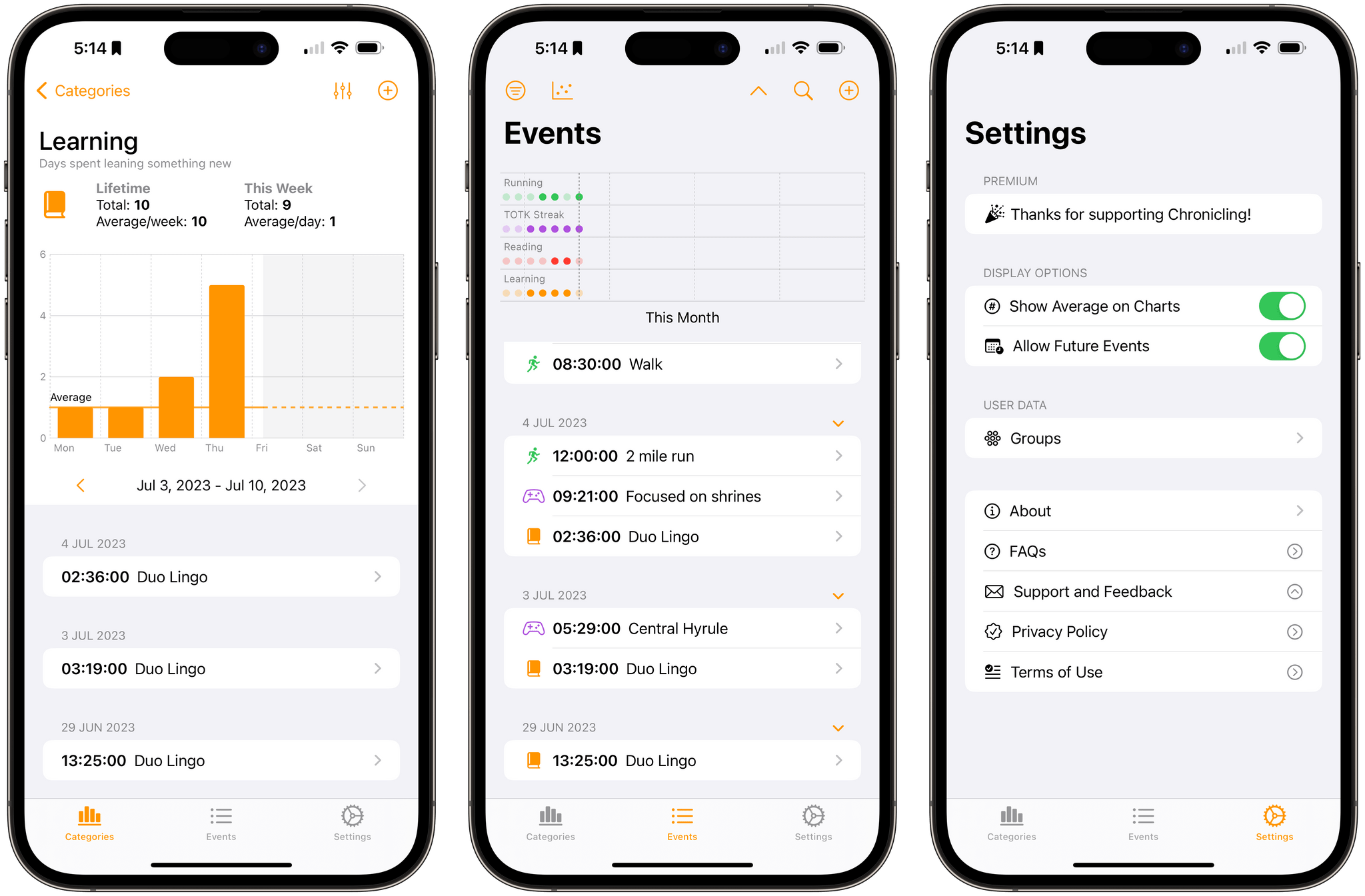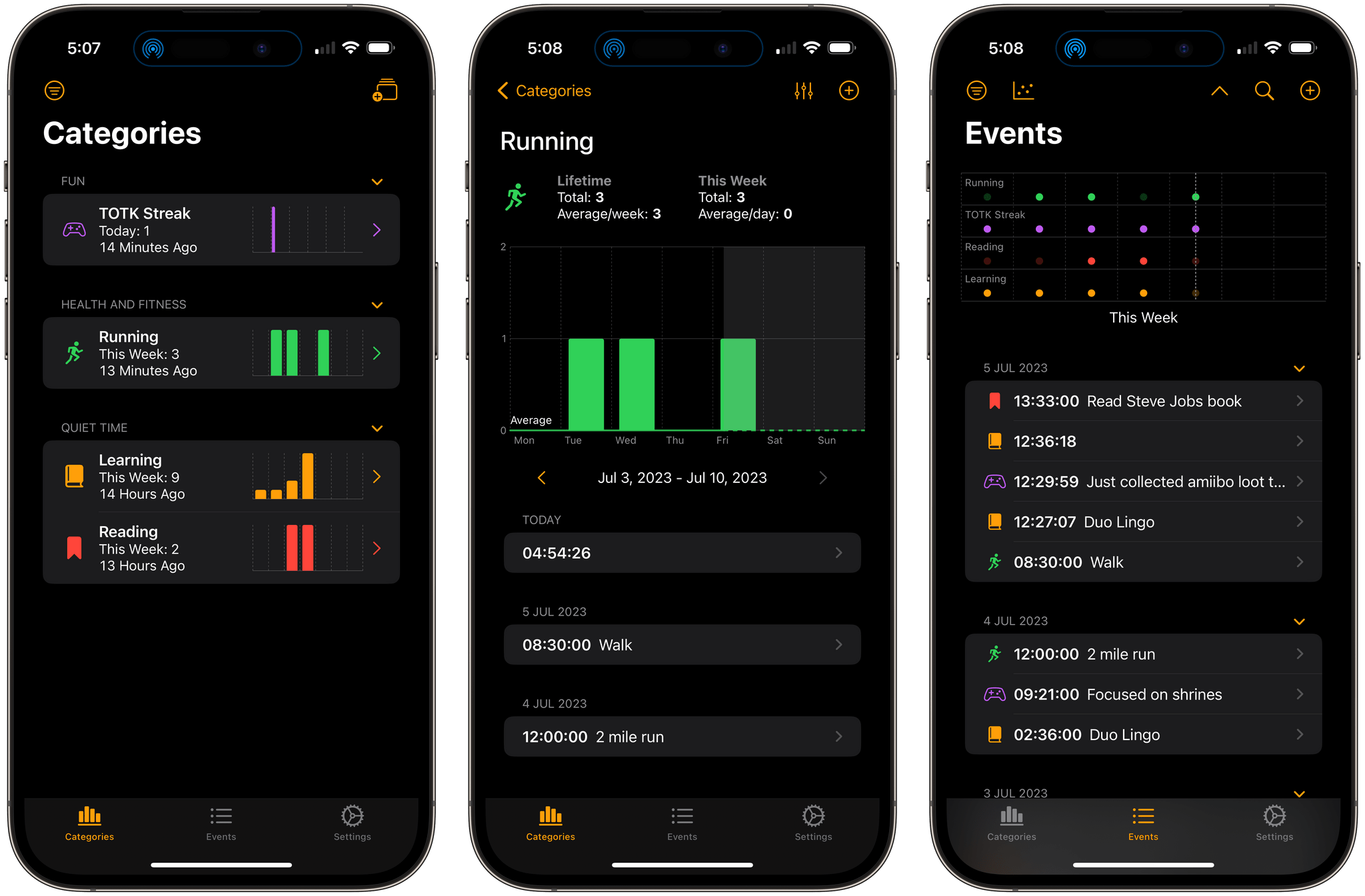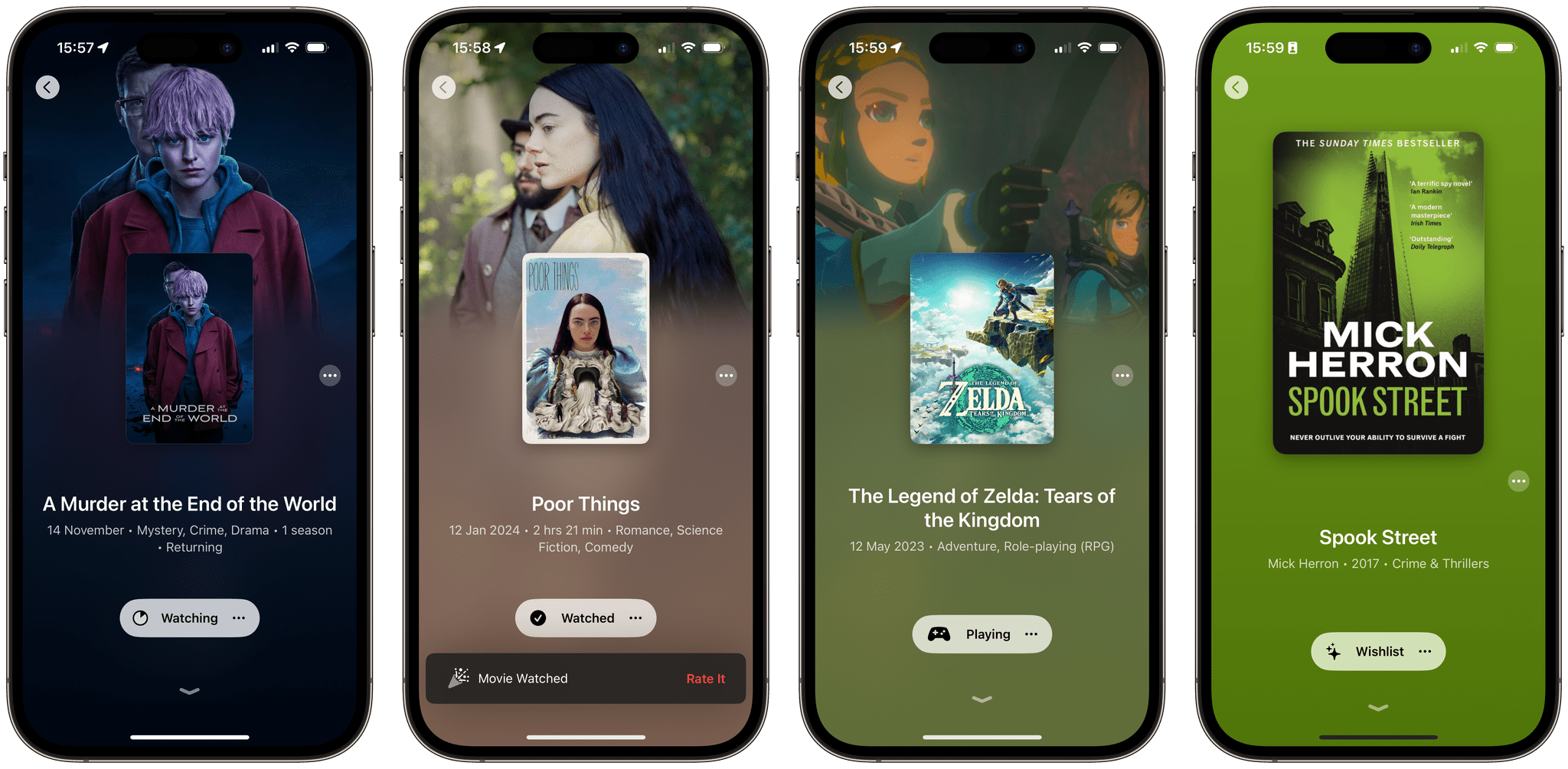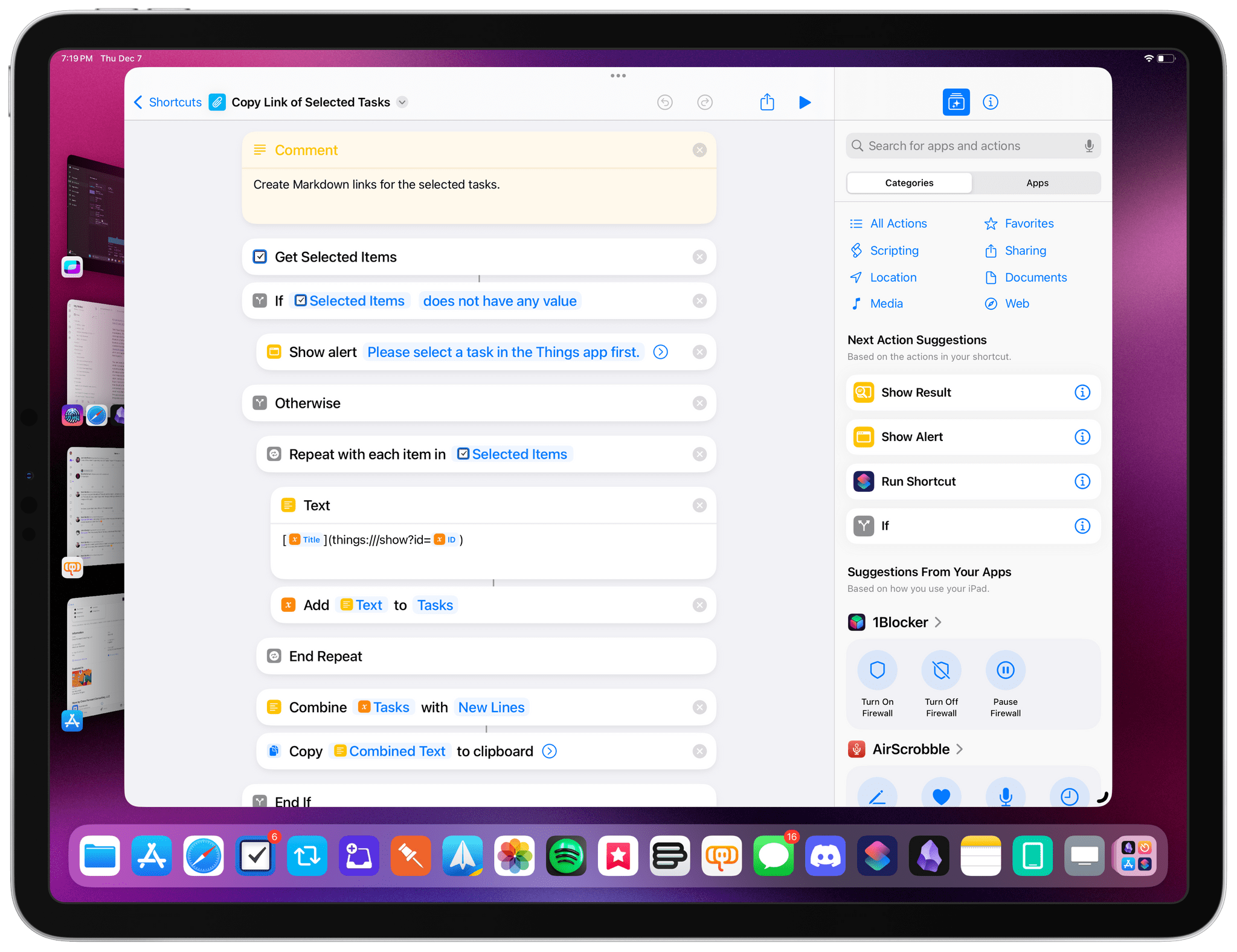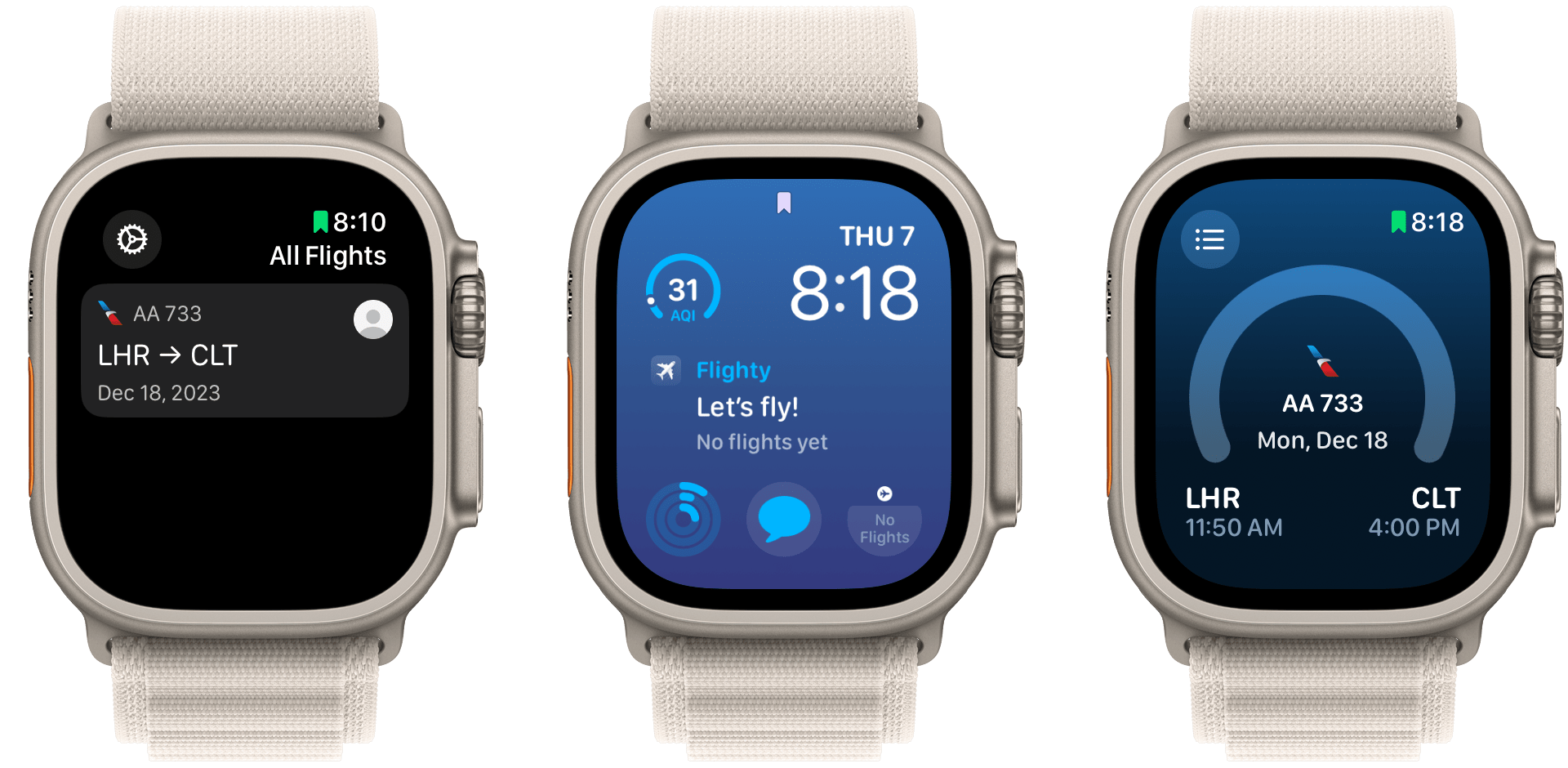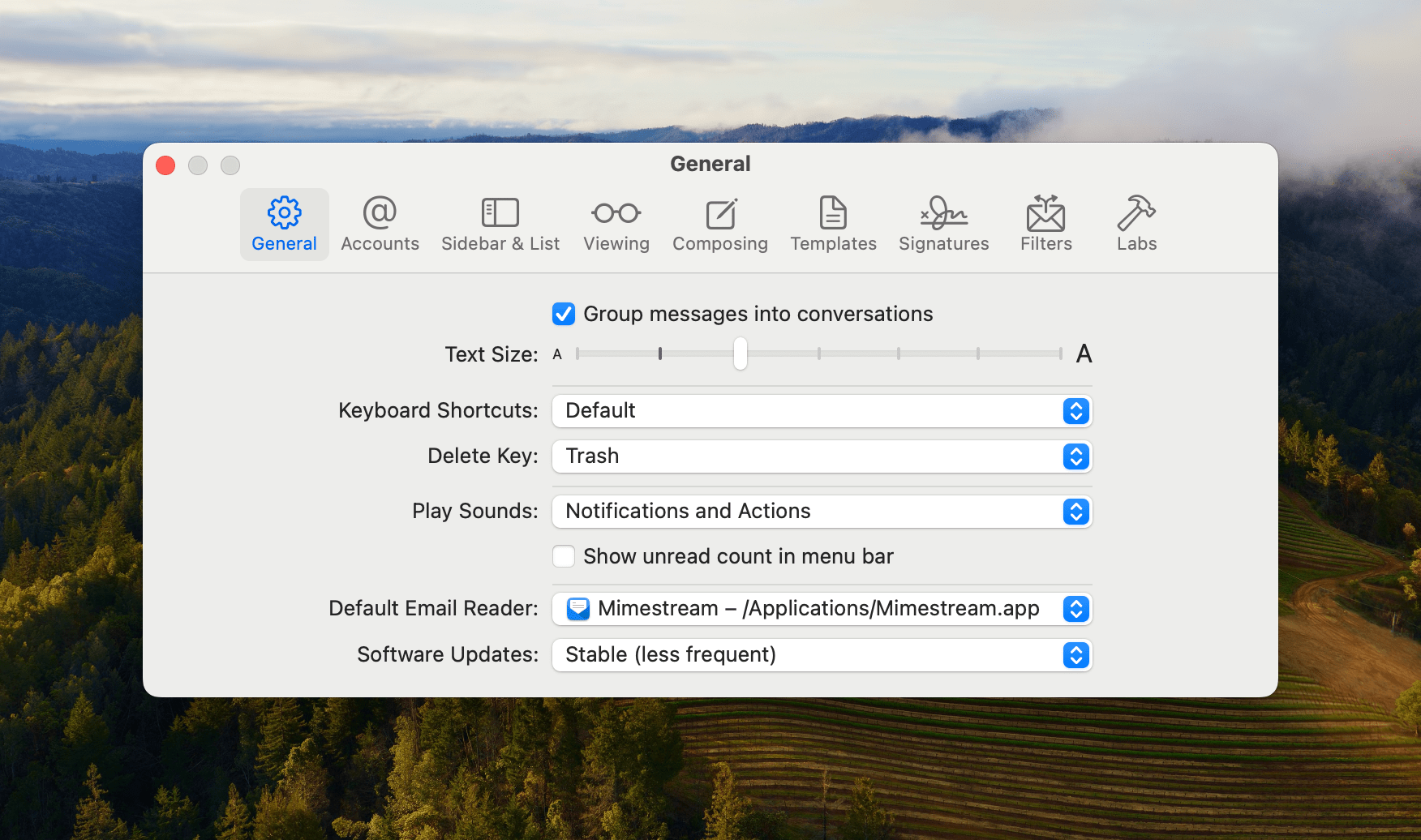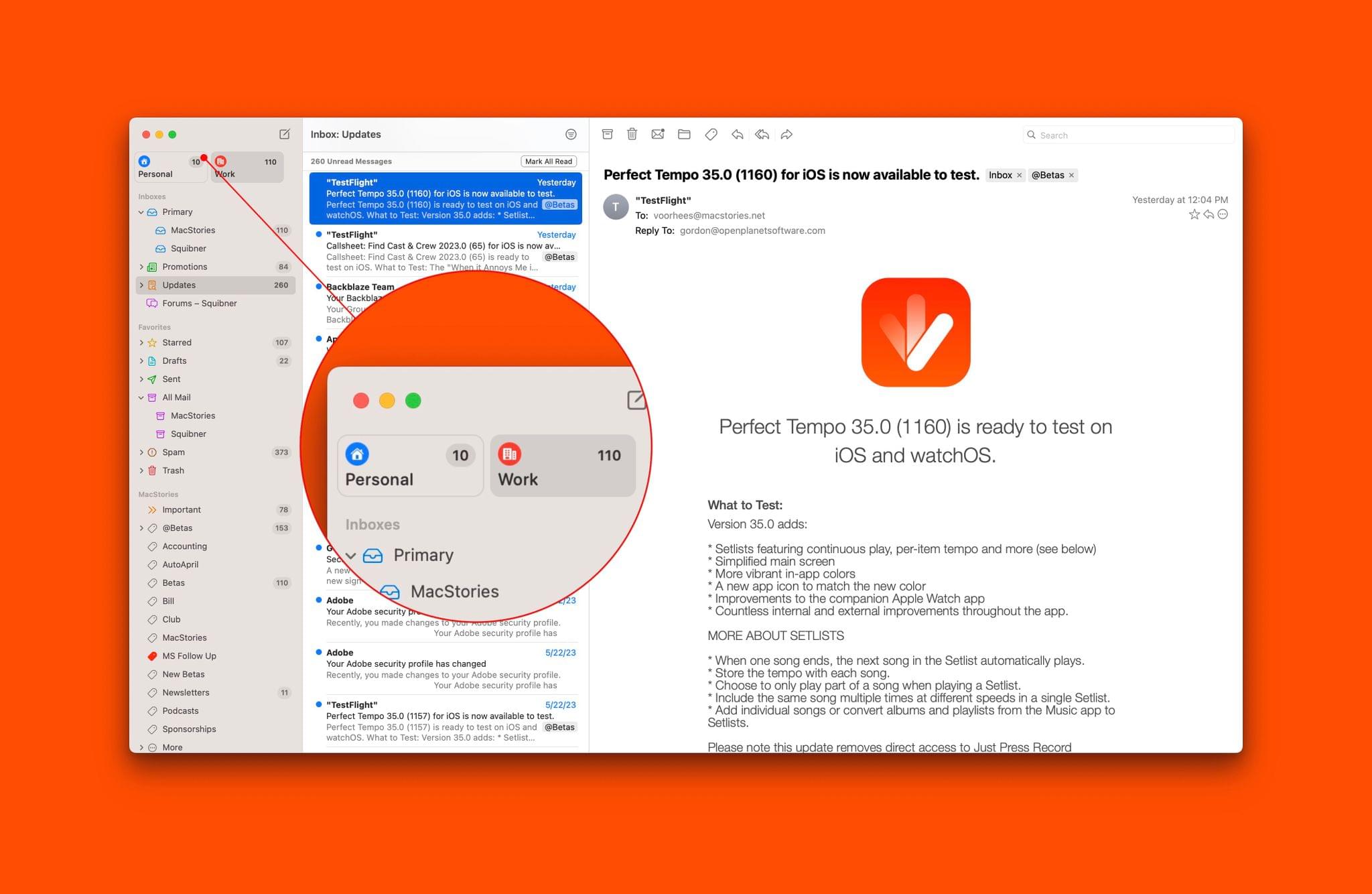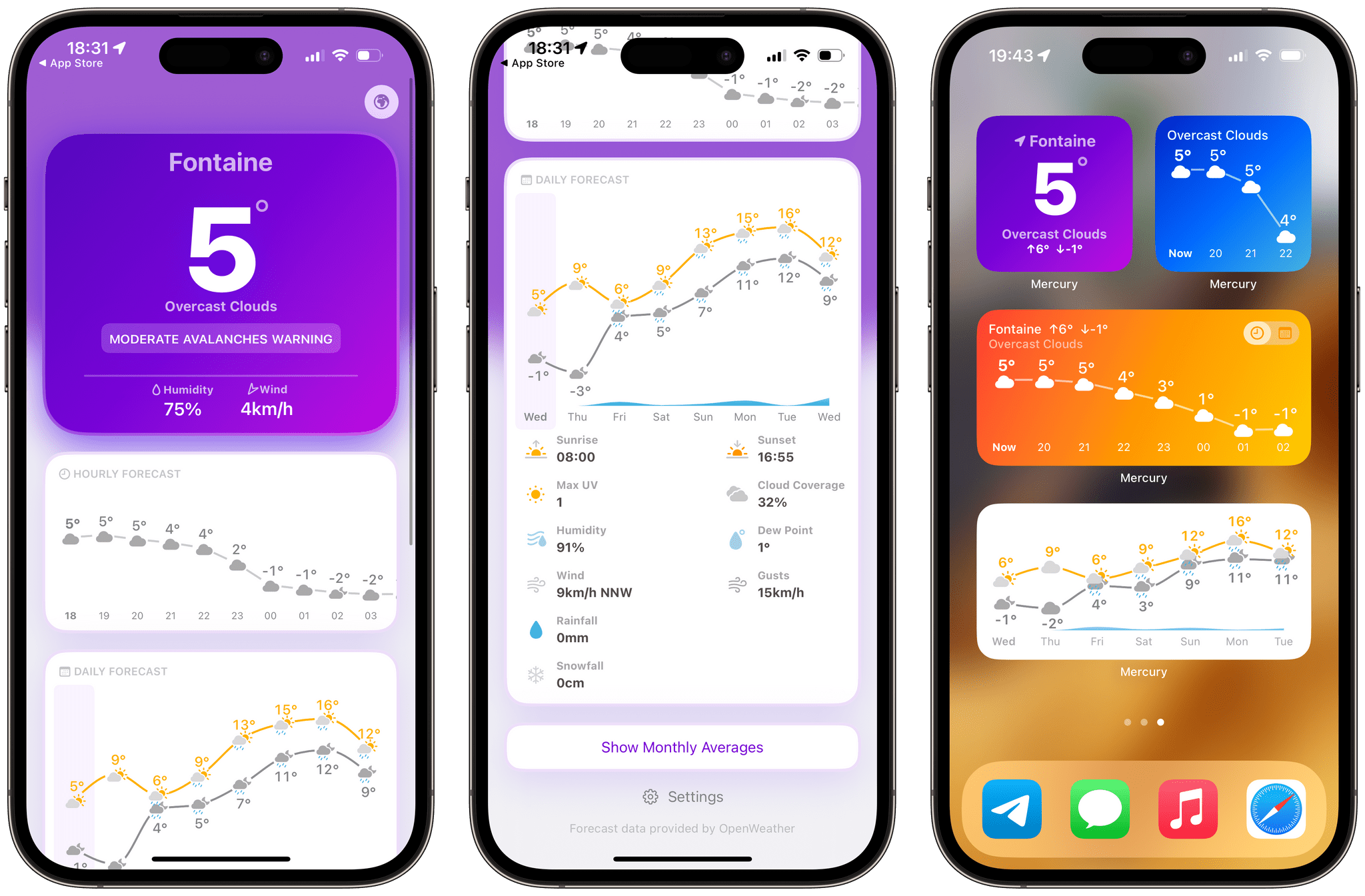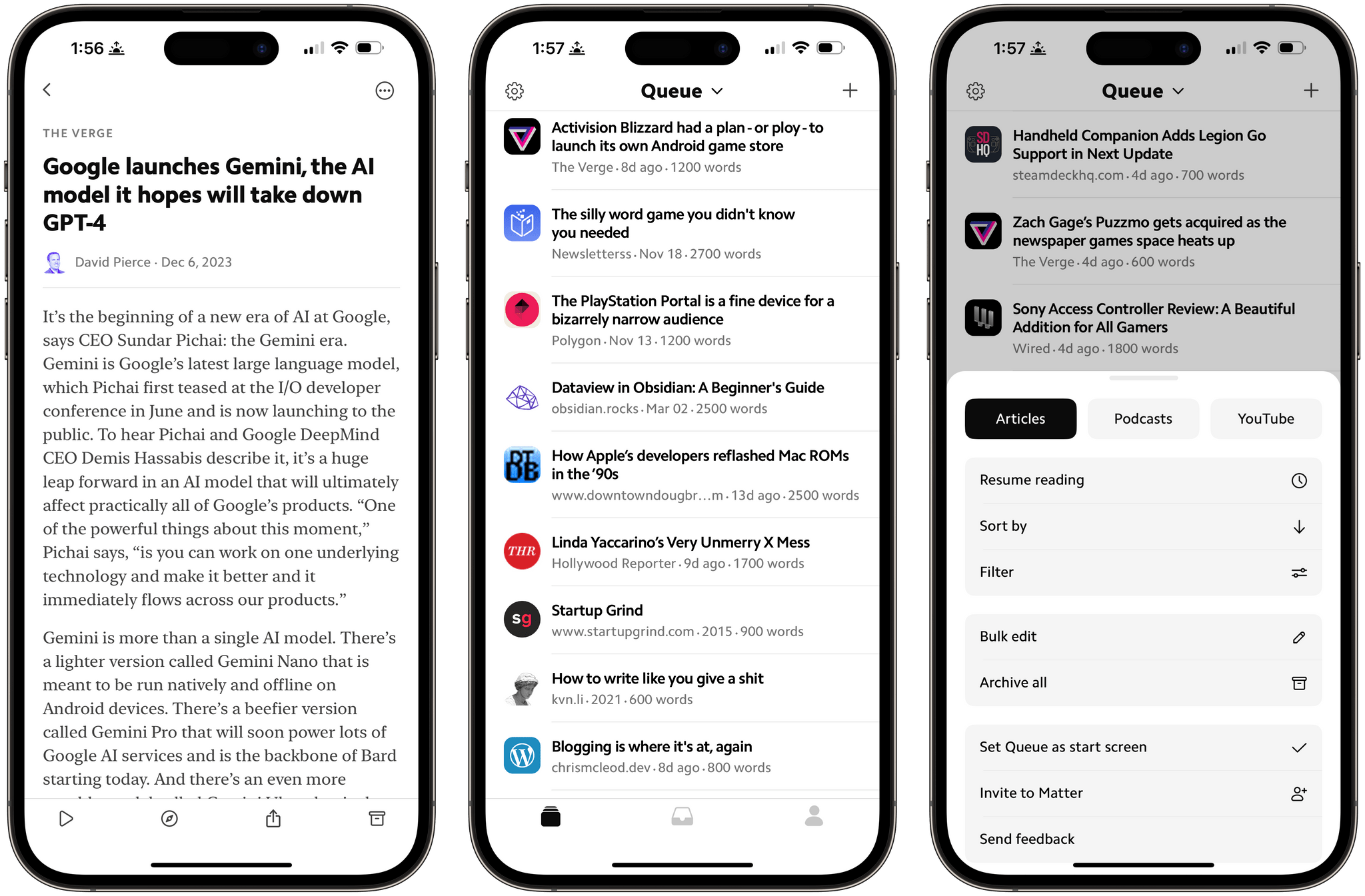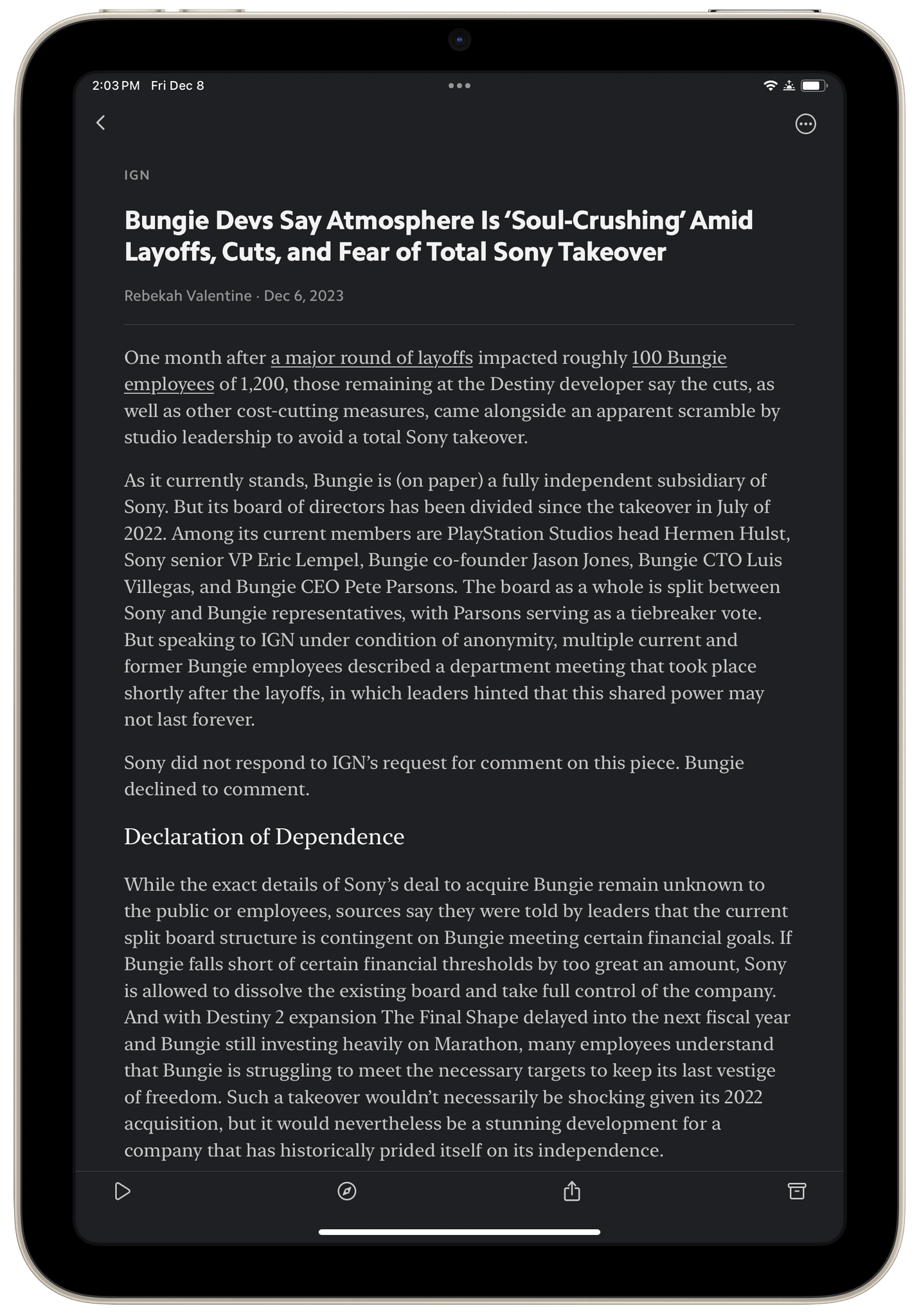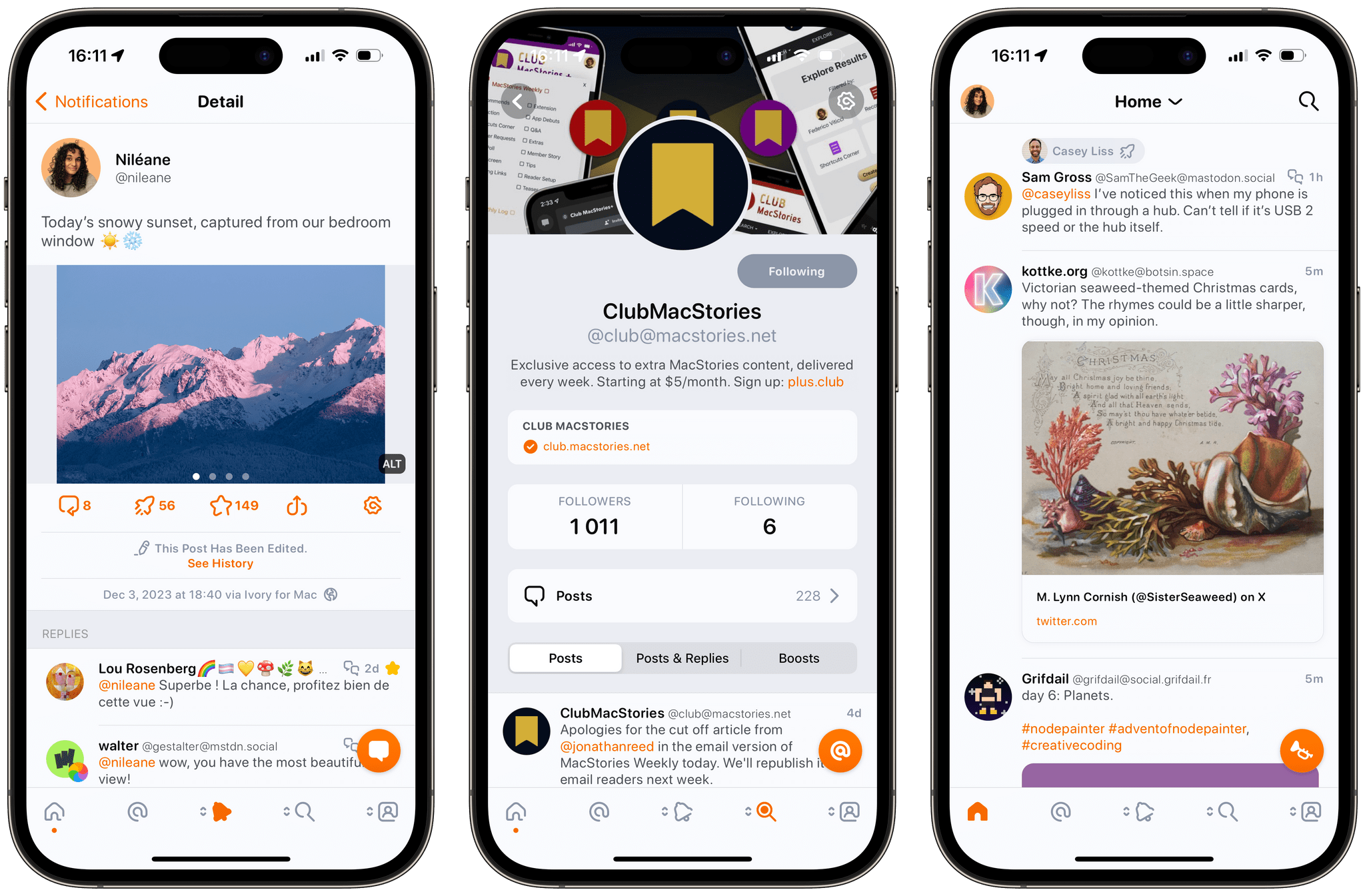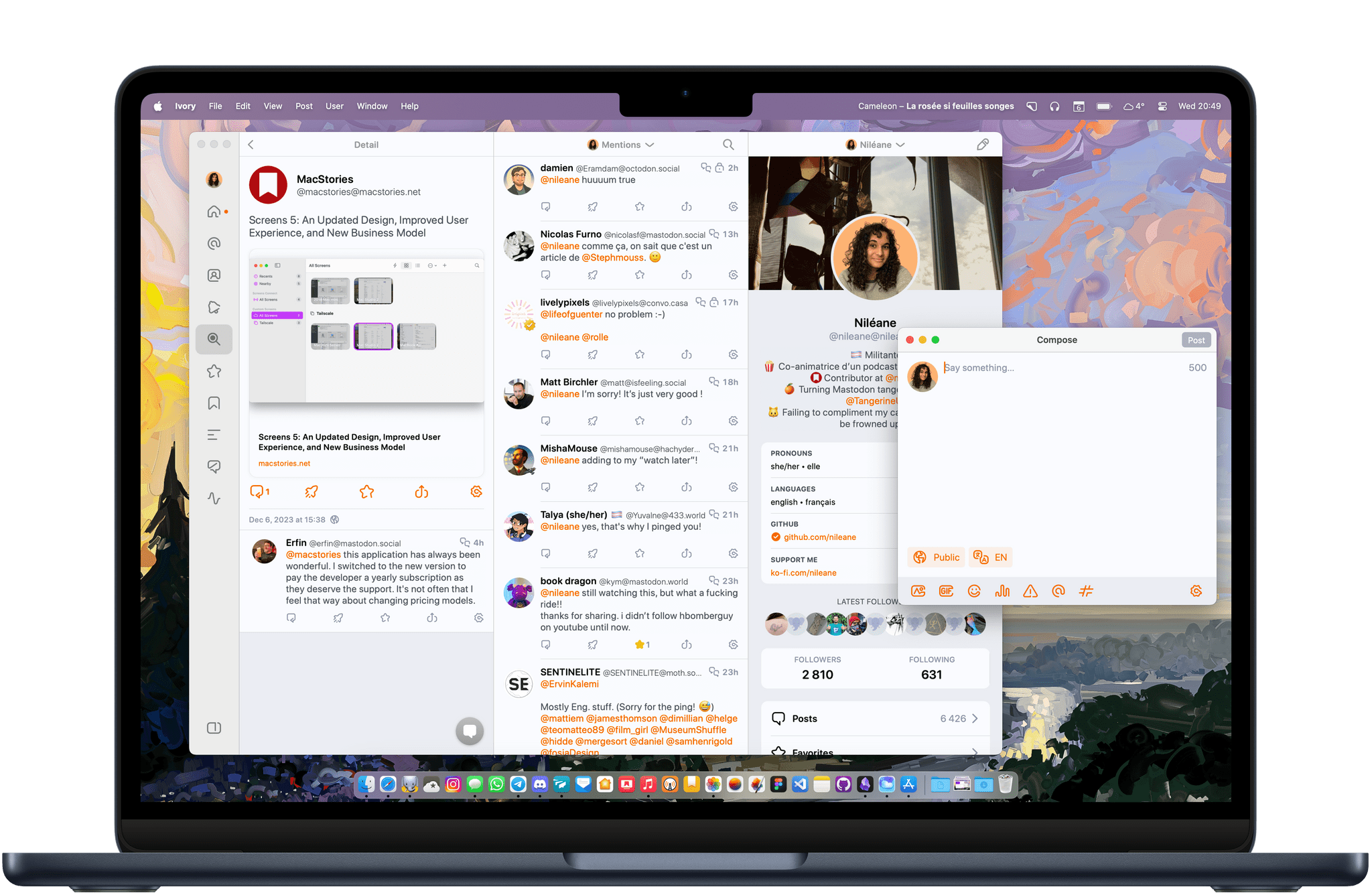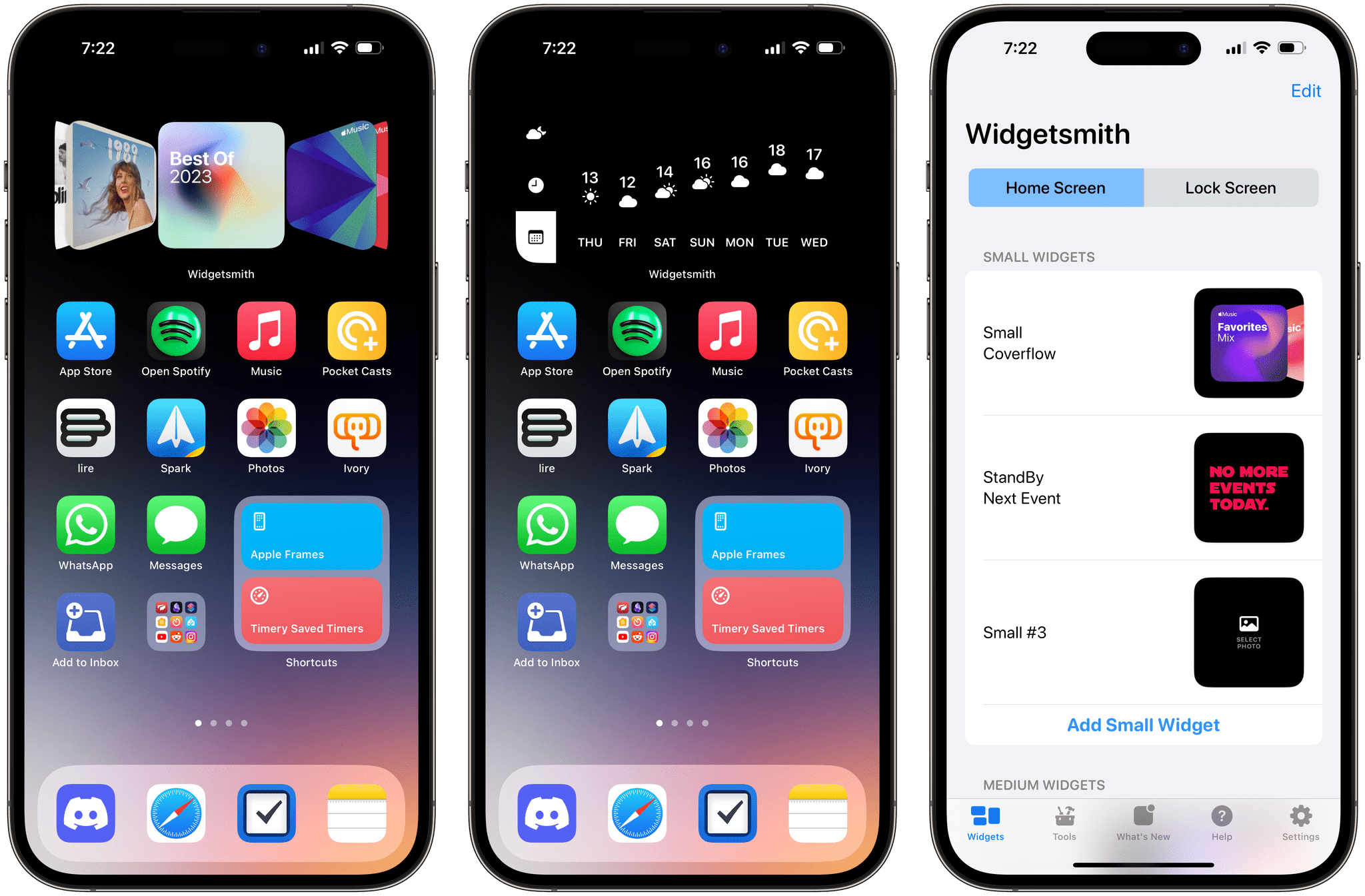John: Every year, it seems like the MacStories Selects awards roll around faster than the last, and this year was no exception. For most people, the year begins on January 1st, but for us, WWDC marks the beginning of our year, and the MacStories Selects Awards feel like its conclusion. Plenty happens the rest of the year, but it’s these seven months that are the main event for us.
June begins with excitement about what developers will be able to do with Apple’s latest frameworks. Reconnecting with developers and meeting new people energizes and carries us through a busy summer and fall. This year marked Federico’s return to WWDC for the first time since the pandemic, and seeing so many developers together made this year’s WWDC the best in years.
2023 was an exciting year for apps. Read-later apps continued to be hot, but nothing was quite as big as interactive widgets, which brought new experiences to our Home and Lock Screens and shook up how many of us set up our devices.
Next year promises to be an even bigger year for apps with an all-new Vision Pro App Store on the way. For now, though, it’s time to pause and reflect on the many apps we tried in the year gone by and recognize the best among them.
Like last year, we’ve picked the best apps in seven categories:
- Best New App
- Best App Update
- Best New Feature
- Best Watch App
- Best Mac App
- Best Design
- App of the Year
But there’s more. Club MacStories members picked the winner of the MacStories Selects Readers’ Choice Award. Plus, as we’ve done the past couple of years, we’ve named a Lifetime Achievement Award winner that has stood the test of time and had an outsized impact on the world of apps. This year’s winner, which joins past winners PCalc and Drafts, is the subject of a special story I wrote for the occasion.
We also recorded a special episode of AppStories covering all the winners and runners-up. It’s a terrific way to learn more about this year’s apps.
You can listen to the episode below.
46:16
So with that, it’s my pleasure to introduce the 2023 MacStories Selects Awards to the MacStories community.
Table of Contents
- Best New App
- Best App Update
- Best New Feature
- Best Watch App
- Best Mac App
- Best Design
- Readers’ Choice
- App of the Year
Best New App
Orion
Federico: It doesn’t happen as often these days as it used to years ago, but my favorite kind of new app is the one that represents a new category of software that’s made possible by a brand new technology added to iOS or iPadOS. This year, while Apple’s focus was on widgets and wrapping up work on visionOS, a new functionality of iPadOS 17 quietly created a whole new market on the App Store: USB video class (or UVC) and the ability to turn an iPad into a portable monitor for connected webcams, videogame consoles, or other devices. We’ve seen dozens of apps that allow you to connect portable consoles or cameras to an iPad running iPadOS 17, but the one we liked most is Orion, developed by Lux.
Orion is an iPad- and iPadOS 17-only app that lets you turn your tablet into a portable HDMI monitor for, well, anything. As long as you own a compatible video capture card (there are hundreds in existence, ranging from $20 dongles to more expensive ones that support HDMI 2.1, HDR, 120Hz, and more), Orion will let you view the connected device’s display on your iPad’s screen. There is no configuration necessary: pick your favorite accessory, plug in a Nintendo Switch, DSLR, or, dare I say, a Game Boy Camera, and Orion will turn your iPad into a monitor.
Of course, the reason we’ve selected Orion as the Best New App for MacStories Selects 2023 is that, compared to its competition, this app goes the extra mile in terms of design, user experience, and raw performance. From a visual standpoint, the folks at Lux – previously known for their outstanding work on the camera app Halide – have outdone themselves: they designed the onboarding experience of Orion and its related manual to resemble the experience of opening up the box of a videogame console from the late 80s; this aesthetic works for the app and turns something relatively boring – we’re talking about HDMI sources, after all – into a fun technological toy. From the app’s icon to the retro-inspired ‘No Signal’ screen, there’s plenty to love about Orion’s design – especially if you’ve been playing videogames for a long time.
What sets Orion apart, however, is how well it works with connected game consoles compared to other solutions we tested this year. As I wrote in a story I published a while back, I’ve been using Orion to turn my iPad Pro’s mini-LED display into a beautiful, portable monitor for my Nintendo Switch. Not only does Orion immediately recognize my HDMI 2.1-enabled capture card, but the app supports an upscaling mode powered by on-device artificial intelligence that can turn any incoming video signal into a 4K image in real time, with no latency or image artifacts. Playing Tears of the Kingdom, Super Mario Bros. Wonder, or any indie games from my Steam Deck on the iPad’s larger, brighter display in upscaled 4K is glorious. Orion offers additional settings to emulate old CRTs and apply other video filters, but, in our opinion, its main attraction is the ability to connect any console or portable PC you want and enjoy a 4K image on an iPad’s display. Even better if you have a Liquid Retina XDR display on the 12.9” iPad Pro.
UVC viewer apps have single-handedly created a new use case for the iPad this year. Orion, with its fun design, reliable connections to capture cards, and solid performance, is the best one we’ve tested yet, and why we’ve chosen it as the Best New App of 2023.
Best New App Runners-Up
Chronicling
John: One of the best things about writing about apps is how often developers surprise us with new approaches to old problems. Just when developers start to converge on a singular solution to a problem, and the apps in a category start to blend together in a samey mishmash, a developer comes along with a fresh take that challenges the conventional wisdom. That’s exactly how I feel about habit trackers. There are a lot of apps in the category, but there wasn’t much new happening until Chronicling came along.
However, suggesting that Chronicling is a habit tracker doesn’t do it justice. It’s fully capable of being used for that task, but the app is much more. It’s that flexibility that I appreciate most about Rebecca Owen’s app. You can easily track literally any recurring event in your life and view the data in multiple ways, teasing out patterns.
Chronicling’s flexibility is tempered by just enough structure to make the data it collects useful. Categories serve as top-level ways to organize whatever you’re tracking, while Events are the things you’re tracking. The app makes it simple to quickly enter data about whatever you’re tracking and then display it graphically in the app or its Home Screen widgets.
In addition to widget support, Chronicling integrates with Shortcuts, Focus Filters, and the latest Apple frameworks, which I love. Perhaps most impressive is that this is Owen’s debut app. With such a strong start, I’m sure we’ll be hearing a lot more from her in the future.
TotK Travel Guide
Federico: Many didn’t think it was possible but, somehow, six years after the release of Breath of the Wild – a game that other videogame developers are still trying to catch up with – Nintendo managed to improve upon it in every single aspect with the highly-anticipated Tears of the Kingdom. I finished the game’s main quest months ago, and I took a bit of a pause from it because I wanted to check out the myriad of other great games that launched in 2023. But I’m feeling the itch to explore the vastness of Hyrule again, and just like I did when I finished the game’s story, I’ll have a precious tool to assist me: TotK Travel Guide, created by indie developer – and previous MacStories Selects award winner – Jeffrey Kuiken.
TotK Travel Guide is the ultimate companion app for Nintendo’s latest masterpiece. The app started as a way to explore the game’s incredibly vast map with the ability to drop pins on points of interest, view the locations of shrines and lightroots, and add notes tied to specific locations on the map. The app, however, has improved a lot since I first covered it on MacStories earlier this year, to the point where it could be described as an all-in-one mapping tool and task manager entirely dedicated to Tears of the Kingdom.
You can create tasks that are associated with specific areas and puzzles, which is a handy way to keep track of all the things you want to check out and complete in a specific part of the game. You can browse a list of all weapons, items, and other collectibles in the game, making sure you don’t miss anything. You can drop pins, view a list of all towns, Hudson signs, statues, caves, Korok seeds, and other landmarks. For a game as big as Tears of the Kingdom, with more things to unlock and discover than Breath of the Wild, you need a digital assistant that can be as comprehensive as TotK Travel Guide. In addition to its large data set – which rivals Nintendo’s official guide and, unlike the book, is interactive – the app comes with a great native design for Apple devices and integration with Shortcuts.
TotK Travel Guide combines two things I love – Zelda and native iOS apps – in a single package that is easily one of the most impressive new app releases of 2023.
Best App Update
Sequel 2.0
Jonathan: 2023 was a big year for entertainment. There were, of course, two of the most significant Hollywood strikes in several decades. There was also ‘Barbenheimer’ at the box office; Mario (2 of them), Spider-Man, Zelda, and Starfield on consoles and PC; an endless amount shows on streaming and, of course, books from any genre or background to read or listen to.
Keeping track of the seemingly insurmountable list of things to watch, play, or read is complicated enough on its own. One way to ease this task is to use a tracking app. There are a handful out there, but one app came out with a big update in 2023 that changed how many of us manage our downtime: Sequel.
Sequel not only released a massive 2.0 update at the end of March but followed that up with another pretty significant 2.1 update in October.
However, the reason we picked Sequel was not for the size of its update but for how the updates genuinely helped many people better organize their clutter.
I and many others got the most benefit with the outstanding refresh of the watchlist for TV series. The next episodes of each series you’re currently watching appear here in ‘Watch Next’ when they’re available and can be easily marked as watched. Two other great sections below that are ‘Upcoming Seasons’ and ‘Upcoming Episodes’. These sections show you the countdown to new seasons and episodes, letting you get ready for them or, in the case of irregular shows like Last Week Tonight, seeing if the show is on that week. As an avid TV watcher, Sequel has proved indispensable in this regard.

Left to Right: The TV watchlist, cast and crew details, rich actor/crew credits, setting up Trakt integration.
But it wasn’t just TV series that saw some love. Across movies and TV, Sequel 2.0 saw the addition of cast and crew, actors, filmography, and integration with JustWatch so you can find which service to watch a title on. That’s not mentioning the laundry list of other additions such as ratings, synopses, trailers, widgets, release reminders, and ‘Time to beat’ for games. Then there was the 2.1 update.
That release brought a much-requested feature: Trakt integration. This, along with cast and crew search, enhanced filmography, and spoiler settings to hide critical information, show that developer Roman Lefebvre isn’t standing still with Sequel.
For myself and many other users, Sequel has become an essential part of how we consume entertainment and why, with the vast updates it made in 2023, Sequel is the MacStories Selects Best App Update of 2023.
Best App Update: Runner-Up
Longplay 2.0
Federico: Created by indie developer Adrian Schoenig, Longplay isn’t the only third-party Apple Music utility to put an emphasis on full album playback rather than playlists or algorithmic discovery of individual songs. Its 2.0 update, however, was an impressive modernization of the app that brought the ability to create custom collections for groups of albums, native Last.fm scrobbling, and a new ‘infinite shuffle’ mode to randomly shuffle entire albums from your Apple Music library.
Longplay still launches to a beautiful grid of albums from your library, which you can explore by simply tapping an album to start listening to it in its entirety – as the artist intended. In version 2.0, though, you have more flexibility in terms of what you want to listen to thanks to collections, which let you create subsets of albums (perhaps grouped by artist, release date, theme, or something else); the addition of iCloud sync also ensures that users have the same Longplay experience across the iPhone and iPad. Last.fm integration is just icing on the cake for all those out there who are still scrobbling. Longplay isn’t for everyone, but if you’re the type of person who enjoys listening to entire albums rather than playlists, version 2.0 deserves a look.
Best New Feature
Things’ Shortcuts Support
Federico: Over the years we’ve been covering Shortcuts on MacStories, we’ve seen our fair share of third-party apps that integrate with Apple’s automation app to let you simplify and speed up your work. But we’d never seen an integration as deep, rich, and well-thought out as Cultured Code’s complete rethinking of Things’ Shortcuts actions.
There are plenty of reasons to love Things, such as its elegant design, excellent collection of keyboard shortcuts, fast sync, and support for Markdown notes in projects and tasks. However, the app’s native support for Shortcuts is something special. Earlier this year, Cultured Code took an app whose automation features largely revolved around URL schemes and an action to create new tasks and turned it into a task manager that supports native Shortcuts automation for every functionality and corner of the experience. You can create, edit, and delete tasks; you can retrieve specific items from projects and items with advanced filters; you can even automate the process of adding sections to a project, allowing you to set up, effectively, project templates that are automatically created on a regular basis via a personal automation, without opening the app at all.
What sets Things apart from other task managers (including Apple’s Reminders) is the app’s awareness of what is currently selected onscreen. With the ability to see which tasks are selected in Things’ foreground window using Shortcuts, you can now put together a new kind of shortcut – a truly contextual one – that acts directly on the selected task to access its properties (such as due dates) and modify them as needed. This is particularly impressive on iPad, where you can pin shortcuts to the iPadOS dock to, say, instantly reschedule a selected task, flag it, or move it to another project. In other task managers, you would have to perform these actions manually; thanks to Things’ Shortcuts integration, you’re free to create your own enhancements for the app. Cultured Code didn’t make a button to change a task’s deadline? You can make your own using the app’s Shortcuts actions.
In our opinion, Things’ Shortcuts integration represents the best breed of user automation on Apple platforms: without much technical knowledge, you can customize and improve the experience of the app by mixing and matching building blocks that don’t require any code, URLs, or other workarounds. There are no apps as tightly integrated with Shortcuts as Things at the moment, which is why the app’s Shortcuts support is the Best New Feature of MacStories Selects 2023.
- Things website
- Things on the App Store (iPhone, iPad, and Mac)
- MacStories article
Best New Feature Runner-Up
Mercury Weather Trip Forecasts
John: It just so happened that Mercury Weather 2.0 was released in the days leading up to a trip I took to the beach, which was the perfect time to test Trip Forecasts, version 2.0’s signature new feature. The problem Trip Forecasts solves is a common one. Your weather app is likely set to show you the weather where you live. So, when a trip is approaching, you find yourself repeatedly searching for the weather at your destination as you plan your trip, or you save the destination in your weather app, which will probably join a long list of other locations of past trips.
With Trip Forecasts, you set your home location, pick your destination and travel dates, and add an icon and optional nickname to represent the trip. Then, when you return to the app’s forecast view, your trip will show up automatically in the forecast timeline with the icon and nickname to distinguish it from your home weather before and after your trip. The feature is simple but elegantly implemented, with a design that highlights one of the reasons we awarded Mercury Weather this year’s MacStories Selects Best Design Award.
Best Watch App
Broadcasts
Jonathan: Internet radio is an odd creature. Broadcasters like the BBC or NPR have public streams and apps available for their stations. However, apps like BBC Sounds have a pretty dire user experience. In the way that you can go to the Music app to listen to any music, there are very few good places to access all radio outside of, well, a radio. And Broadcasts.
For several years now, Broadcasts has provided a great user experience, allowing you to add any public stream to the app as a ‘station’. But developer Steve Troughton-Smith didn’t stop there. He’s continually added more features, supported more Apple platforms, and included new APIs as Apple introduced them – the latest being SharePlay.
Broadcasts released significant updates this past year to its iOS, iPadOS, macOS, and even tvOS apps, but the 3.3 update to the watchOS app caught our eye for this award.
First, the watchOS app received a complete redesign. It’s nothing too complicated, but that’s the beauty. It takes advantage of the entire screen in the way that the Music app has in watchOS 10. It pushes everything to the edges, leaving more space for the artwork and station info. That artwork creates a blurred background, creating a beautifully clean UI. This artwork can then change to reflect the song on the radio station due to the Shazam integration in the iOS app.
The other part of the app allows you to view your stations in a visually appealing grid or if you have a lot of stations, an easily scrollable list. And that’s it. The app doesn’t need to be anything more than that because, as well as the elegant UI, it’s blazingly fast. Tap a radio station, and it will almost instantly start playing from a stream. That includes cellular, something that Apple Watch streaming apps often struggle with. I switched to Broadcasts to listen to my favorite radio station, BBC 6 Music, because the differences in speed between Broadcasts and the BBC Sounds app were night and day. Embarrassingly so.
Broadcasts does one core task, listening to Internet radio, and it does so with a clean UI and at great speed, whether over cellular, Wi-Fi, or in partnership with the iOS app. That is why we are awarding Broadcasts the MacStories Selects award for Best Apple Watch App of 2023.
Best Watch App Runner-Up
Flighty
John: Flighty came to the Apple Watch later than many of the apps I use, but when it debuted this past fall, it didn’t disappoint. The Watch app opens to a list view of all the flights that you’ve previously saved on another device. Tap one, and you’re presented with the signature card-like interface of watchOS 10.
Flightly includes three views for each flight. A progress view that displays the start and endpoints of your journey, airline, flight number, and takeoff and landing dates and times. Once the flight takes off, the ring around that information fills in, giving you a quick visual indicator of its progress. The second and third cards are dedicated to more detailed departure and arrival information, such as whether the flight is on time, the departing gate, and where you can pick up your luggage. The app also includes a setting for including or excluding friends’ flights from the Watch app, which is a nice way to help manage your list of flights.
Of course, Flighty also includes complications to check the progress of flights at a glance. I found that the app’s simple circular complication that tracks the progress of an arriving flight was perfect for quick glances over Thanksgiving when I was picking my kids up from the airport.
The one thing that I’d like to see added to Flighty’s Watch app in the future is the ability to add flights from your Watch. Especially if you already know the airline code and flight number of the flight you want to track, adding it and a date via the Watch strikes me as workable, even on the Apple Watch’s small screen. That said, Flighty’s first foray into watchOS is a fantastic start that is both useful and in line with the app’s reputation for design excellence, which is why we chose it as a runner-up for this year’s MacStories Selects Best Watch App award.
Best Mac App
Mimestream
John: The greatest compliment I can give Mimestream, which I reviewed earlier this year, is that I’m willing to use it, even though it’s only available on the Mac. That’s not a big deal for everyone, but I work across my Mac, iPad Pro, and iPhone every day, and switching email apps depending on which platform I’m using isn’t ideal, especially since nothing on iOS or iPadOS comes close to Mimestream on the Mac. It’s Mimestream’s meticulous commitment to quality that makes me willing to wait for its promised iOS and iPadOS app.
Mimestream only works with Gmail, so it’s not an app for everyone. However, it just so happens that all but one of my email addresses are Gmail-based. I’ve never been a fan of Gmail’s web app, and using Gmail in a traditional email client often means foregoing some of its unique features. Historically, another option was to find a third-party app that integrated with Gmail. I’ve tried a lot of those over the years, but none ever stuck because most were non-native web wrappers that are little more than a skin on top of Gmail.com.
Mimestream is different. The app is made by a small team led by a former Apple engineer who worked on Apple’s Mail app. That lineage shows. There are echoes of Mail throughout, but Mimestream takes email even further. The app is a thoroughly native app that uses Google’s latest Gmail APIs to offer fast, reliable messaging that takes advantage of the features that make Gmail different.
The app supports a long list of modern email features like:
- Undo send
- An experimental client-side snooze feature
- Tracking prevention
- Templates
- Google Calendar and Contacts integration
- Message labeling
- Conversation threading
- Automatic message categorization
However, my favorite feature is profiles, which lets you manage multiple Gmail addresses in user-defined groups. I’ve got ‘Personal’ and ‘Work’ profiles, which is probably the most obvious use case for profiles, but there are plenty of other ways to organize messages, so you’re not faced with one monolithic inbox full of messages when all you want to do is deal with work messages, for example.
Another excellent feature is the ability to set up Gmail message filters inside Mimestream’s settings. I use filters to do things like separate new app beta testing invitations from the many beta update emails I get from TestFlight. The new betas get a special label that makes it far easier to find those messages among the many TestFlight messages I get every day.
Aside from iOS and iPadOS versions of Mimestream, I’d also love to see Mimestream adopt deep-linking of messages and Shortcuts support. It’s possible to copy Gmail URLs that open messages on the web, but I’m using Mimestream because I prefer it over Gmail’s web interface, so a URL that opens Mimestream would be better. Shortcuts support would also allow me to integrate Mimestream with apps like task managers and other apps I use alongside my email client.
Those limitations aside, there hasn’t been an email app I’ve ever tried on any platform that outshines Mimestream. It maintains a carefully considered balance between power user features and a robust native UI, combined with Google’s latest Gmail APIs that transcend Gmail as a service. That makes Mimestream one of a handful of Mac apps that I consider essential to my everyday work and why we’ve named it the 2023 MacStories Selects Best Mac App.
Best Mac App Runner-Up
Bartender 5
Niléane: In 2023, for the first time in two years, Bartender received a major new update. Bartender had already established itself as a must-have for any Mac users who need to declutter their menu bar.
Now, not only was Bartender 5 a great maintenance update that allowed it to run seamlessly on macOS Sonoma, but it also introduced some impressive new advanced features, along with fun new options to fully customize the menu bar’s appearance. The lovely new menu bar style settings make it possible to change the color of the menu bar, add a border or drop shadow, or even change the way it fills the top part of your screen.
In addition to the new style options, Bartender 5 lets you group multiple icons together, and the app has made its triggers even more powerful than before. You can now use AppleScript to dynamically rearrange icons in your menu bar, even going as far as automatically switching between entire menu bar presets. Thanks to this, Bartender allows me to hide the battery icon when my MacBook is plugged in, hide the music icon when none is playing, show the Time Machine icon when a backup is in progress, and even show a completely empty menu bar when ‘Do Not Disturb’ is enabled.
I honestly cannot imagine being able to enjoy my MacBook Air’s 13-inch display to the same extent without Bartender, and the many ways it helps me efficiently use the limited space to the right of the notch. The app has solidified itself as a super advanced tool for anyone who needs it to be, but it is still the simple utility that handles your overflowing menu bar icons for you. For this reason alone, Bartender 5 is easy to recommend to anyone running a Mac.
Best Design
Mercury Weather
Niléane: As an aspiring weather enthusiast, I love trying out new weather apps, especially ones that provide a plethora of data points and graphs in their user interface. But it’s not often that a weather app like Mercury Weather manages to catch my attention. Contrary to many other weather apps, Mercury Weather is a modern app that is designed to be both beautiful and delightfully simple.
Mercury Weather uses a palette of elegant gradients to illustrate the current temperature and conditions. Combined with a great use of typography and generous white space, the forecast is always a pleasure to read. Even on a hazy day, the app feels joyful. My favorite aspect of Mercury Weather’s design is how it lays out the forecast on a neat graph line, which combines the temperature, condition, and precipitation probability in a way that never looks too crowded. This makes it easy to tell at a glance whether it’s about to get colder or warmer, and whether you should take an umbrella with you before heading out. The app’s fantastic design is the perfect showcase for how to present the right amount of basic data points in a way that remains digestible and easy to read.
Mercury Weather’s refinement can be appreciated on all of Apple’s platforms. The app makes great use of horizontal space on iPadOS, and its forecast graph is available right from the menu bar on macOS. Mercury Weather also takes advantage of the new interactive widgets in iOS 17, and even offers a large selection of small widgets in StandBy mode, which stand out with their colorful icon set.
With the addition of trip forecasts this summer, Mercury Weather has achieved an impressive balance between being a helpful weather companion on the road, and having a clear, well-thought-out user interface. The app has found its way into my collection of weather apps, outshining even the most advanced few of them solely by virtue of its beautiful design.
Best Design Runner-Up
Matter
John: I try new reading apps all the time. Most of my reading happens in an RSS client or read-later app, so I’m always on the lookout for something that improves my setup in some way. For the past couple of years, that’s increasingly meant trying an ever-expanding universe of read-later apps.
At one point or another, I’ve tried virtually every read-later app, but since Matter abandoned its social sharing focus to refocus on its core reading experience, it’s become the app that I come back to again and again. A big part of that is that Matter gets the fundamentals right. The text parser is excellent, and there are multiple ways to organize and rediscover articles you’ve saved for later.
However, the other piece of the puzzle is design, which is why Matter is our runner-up for this year’s MacStories Selects Best Design award. Matter doesn’t try to be everything to everyone. Instead, it focuses on the reading experience. There’s no one thing that elevates the experience of reading in Matter over other apps. The combination of tasteful typography and a layout that preserves bylines, publication dates, and publisher information makes a great first impression. But features like the many ways to sort, filter, and tag saved stories, along with syncing to the furthest-read spot in an article, set Matter apart. It’s a design that isn’t just about saving links or processing data. It’s also one that understands readers and the experience of reading.
One place where I think Matter’s design falls short is its lack of integration with other apps and platforms. Matter has a single Shortcuts action to add articles to your queue, but none to send them to another app. Also, the app’s excellent audio feature for reading articles aloud doesn’t let you send the audio to another app for listening or offer an Apple Watch app or CarPlay support.
That said, there is no better way to read a longform article you saved for later than sitting down with Matter on an iPad mini. Everything about it feels like a premium experience, free from the noise that probably surrounded the article on the web, making it my favorite way to read in 2023.
Readers’ Choice
Ivory
Niléane: This year’s Readers’ Choice award comes as no surprise. When Ivory by Tapbots launched in January, Twitter was crumbling, and entire communities were scrambling to find a new home. Ivory immediately materialized Mastodon’s potential to be a prime candidate for becoming one of the main new places to hang out online, delivering what we believe to be the best-designed experience for using the decentralized platform.
Building on a decade-strong foundation, Tapbots has crafted the app with a rarely matched level of care and refinement, and has incorporated advanced features in Ivory — like timeline filters, and a customizable UI — right from the beginning. Not only that, but since Federico first reviewed the app, Tapbots has steadily been keeping up with Mastodon’s evolving feature set. Today, Ivory almost allows you to use and configure your Mastodon account without ever having to rely on the web interface — which is not something that can easily be said for many other Mastodon apps. The app is fast, smooth, and its thoughtful use of gestures, haptics, and beautiful iconography make it a delightful experience.
As a result, Ivory has become a staple of Mastodon’s ecosystem in only a matter of months. The app has helped thousands of users make the transition to Mastodon and the Fediverse, and Ivory’s design has even directly inspired the developers behind Mastodon in revamping the search experience on the Web.
After launching on the Mac in May, and now closing in on its first-year anniversary, Ivory’s lovely design and popularity naturally crown it this year’s top choice for browsing Mastodon on Apple’s platforms — and, with more and more platforms adopting ActivityPub, the protocol used by Mastodon, we can only envision a bright future ahead for Tapbots’ new flagship app.
App of the Year
Widgetsmith
Federico: Few indie developer stories are as remarkable, heartwarming, and inspiring as the story of David Smith, also known in our community as ‘Underscore’.
Smith has been making apps for Apple devices since the launch of the App Store in 2008, and he’s consistently been at the forefront of integrating with the latest Apple technologies, device screen sizes, and new platforms. After a decade of work on apps that ran the gamut of functionalities – from audiobooks and pedometers to podcast clients and time zone calculators – Smith found his “overnight success” in 2020 with Widgetsmith, a utility that took advantage of iOS 14’s Home Screen widgets to let users customize the most important pages on their iPhones with all kinds of elements such as text, calendar events, photos, and more. The app took off, became a viral sensation, and has grown over the years into a piece of software that’s been downloaded over 100 million times from the App Store. But it wasn’t an overnight success: it was the result of over a decade of quality work that put Smith in the right place, at the right time. As the saying goes, fortune favors the prepared mind. And Smith, as is always the case with his apps, was prepared.
To be honest with you, dear readers, we could have given an award to Widgetsmith years ago, and it would have been well deserved. But I’m glad we waited until iOS 17’s interactive Home Screen widgets because the Widgetsmith we have today is a more powerful, more intuitive, and more useful tool that takes Home Screen customization for iPhone and iPad to the next level, in a way the original Widgetsmith for iOS 14 never could.
Thanks to widget interactivity in iOS and iPadOS 17, Smith has been able to turn Widgetsmith into a modular playground for system features that you can put on the Home Screen with the design you choose. Perhaps you want to create an interactive calendar widget that lets you view events for the day you select in the widget; Widgetsmith lets you do that. Or maybe you want to have a compact weather forecast with the ability to switch between hourly and daily predictions from the same widget; Widgetsmith also lets you do that. It gets even better if you’re an Apple Music user: in an incredible throwback to the days of the iPod and iTunes, Widgetsmith now comes with a new Cover Flow-inspired widget that lets you flick through albums and playlists to start playing them directly from the Home Screen. It’s wild.
It’s kind of scary to consider the amount of options for colors, layouts, fonts, and types of widgets that are now available in Widgetsmith and that have been augmented by the addition of inline interactivity. And I haven’t even mentioned the app’s integration with StandBy – another area of iOS that you can fully customize with Widgetsmith now – its seasonal theme updates, or its series of ongoing updates, which included, among other things, a monthly calendar widget that lets you select individual days on the right side to view events on the left.
There are hundreds of other widget apps on the App Store, but there’s nothing else quite like Widgetsmith. The app strikes a unique balance of visual theming and power-user features that are presented in an easy-to-use, reliable, well-designed experience made by someone who clearly understands the ins and outs of the platforms he’s developing for. That’s the kind of quality only 15 years of experience and iteration can buy.
Widgetsmith has revolutionized how people think of their Home Screens, and it’s doing it again with iOS and iPadOS 17. For all these reasons, Widgetsmith is our App of the Year.
App of the Year Runner-Up
Ivory
Federico: What else can I say about Ivory that hasn’t already been said in other sections of this very story? Tapbots’ magnificent comeback to the App Store has, at least for me, redefined my approach to a timeline-based social network. I know that the whole point of Mastodon and decentralized networks is the ability to use whatever client you prefer, but when I think of using Mastodon on Apple devices, I think of Ivory.
Like other apps we’ve awarded before, there’s something special about Ivory that makes me return to the app every time I try something else. Maybe it’s the polished, fun design imbued with personality by longtime Tapbots designer Mark Jardine. Maybe it’s the buttery-smooth scrolling and overall performance made possible by developer Paul Haddad’s experience with social timelines and Apple platforms. Or maybe it’s the combination of all these factors that turn Ivory into an experience that’s greater than the sum of its parts. Ivory may have not reinvented the classic Tweetbot look, and there are still a lot of features Tapbots should add to match the functionality of more versatile competitors, but Ivory is the new app I’ve used most in 2023, and it deserves recognition in this category as well.











